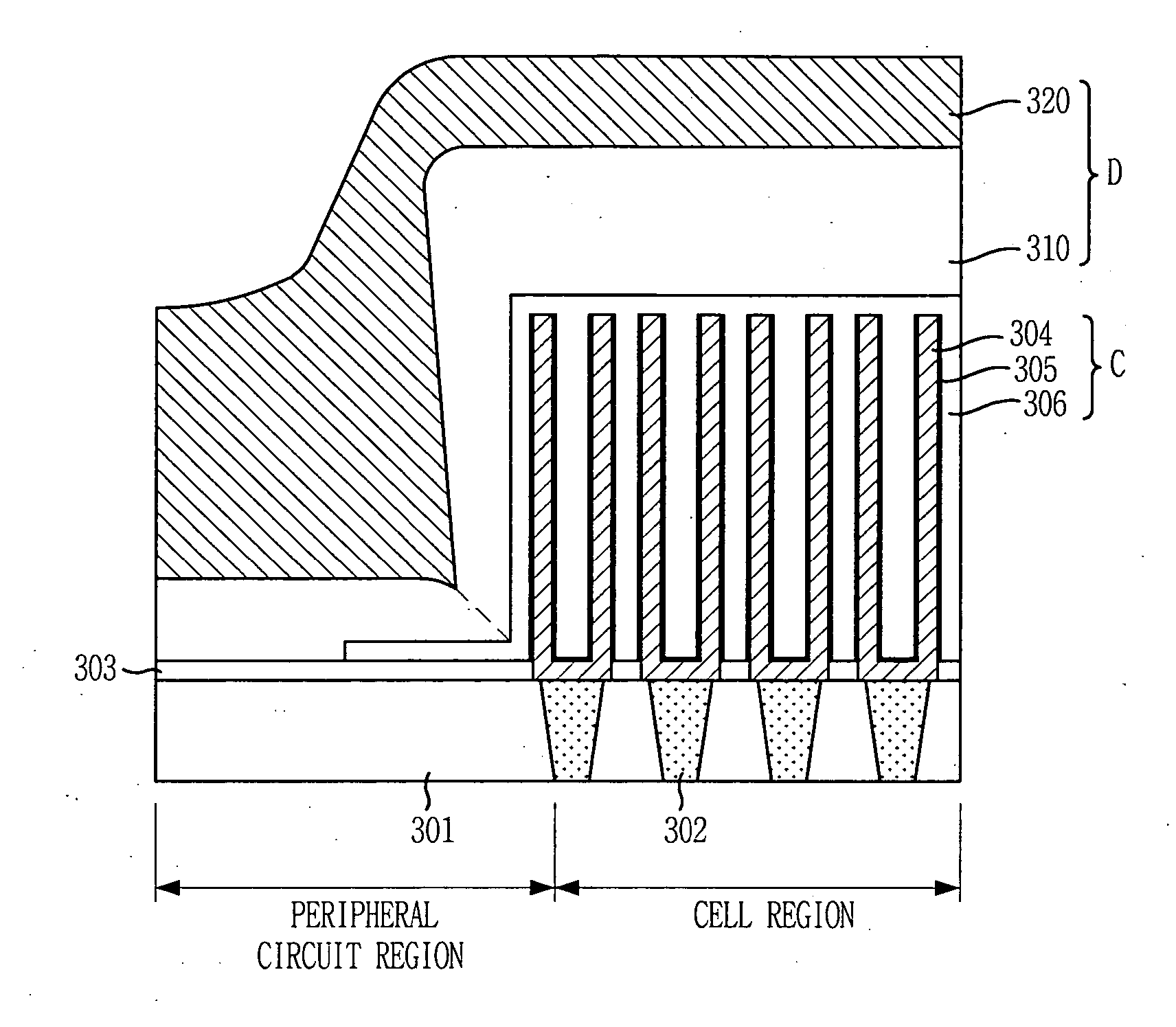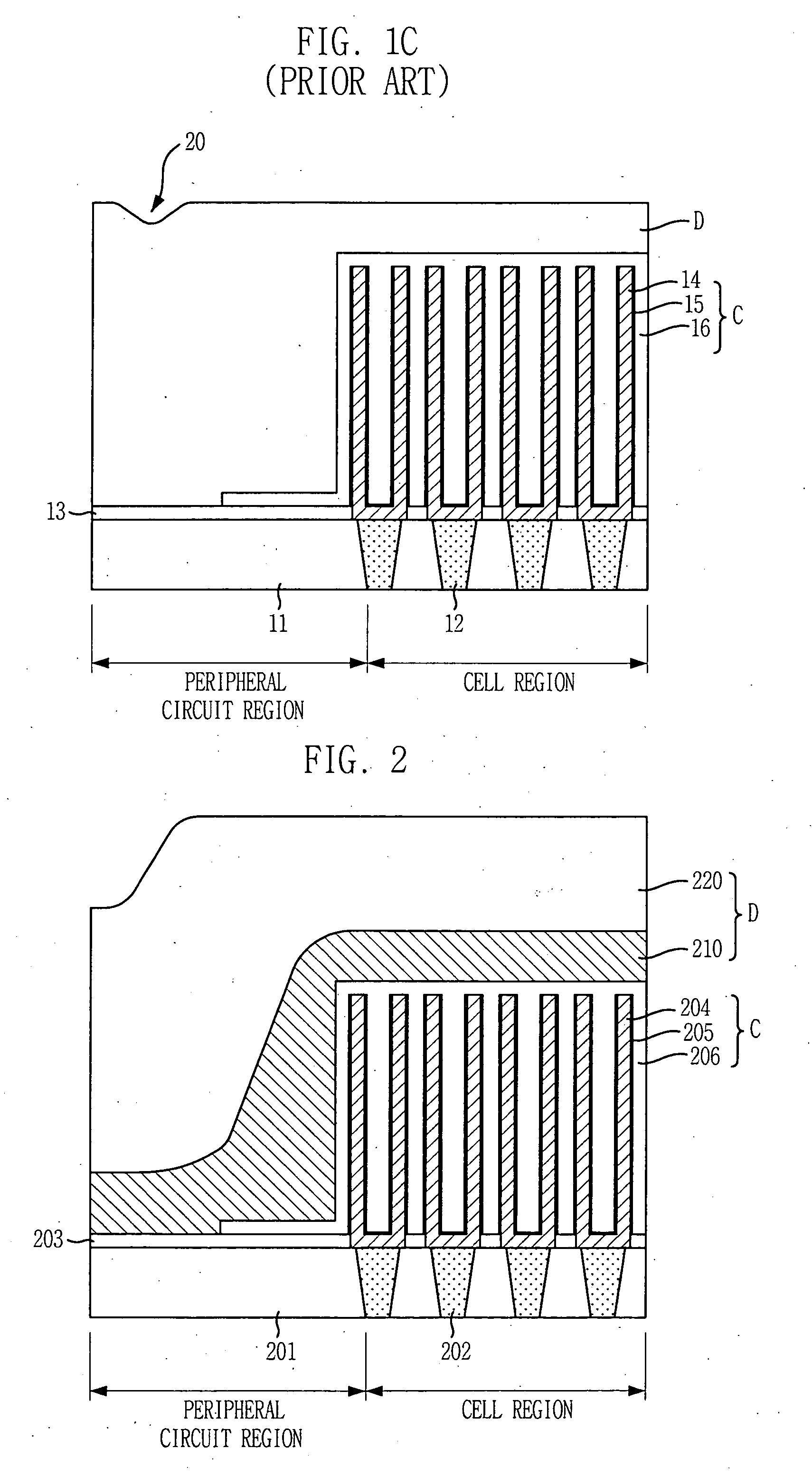Semiconductor device with flowable insulation layer formed on capacitor and method for fabricating the same
a flowable, capacitor technology, applied in semiconductor devices, semiconductor/solid-state device details, capacitors, etc., can solve the problems of generating plasma damage on the bottom layer consisting of capacitors, and the inability to perform a low-temperature process with bpsg, etc., to achieve good planarization characteristics
- Summary
- Abstract
- Description
- Claims
- Application Information
AI Technical Summary
Benefits of technology
Problems solved by technology
Method used
Image
Examples
first embodiment
[0026] First, FIG. 2 shows one exemplary substrate structure in accordance with the present invention.
[0027] As shown, a plurality of capacitors C are formed on a substrate provided with a first insulation layer 201, contact plugs 202 and an etch stop layer 203. Each of the capacitors C includes a lower electrode 204 being contacted to the contact plug 202 and having a cylinder shape, a dielectric layer 205 covering the lower electrode 204 and an upper electrode 206 formed on the dielectric layer 205. The capacitors C are formed in a typical DRAM cell region and are not formed in a peripheral region. Hence, there exists a height difference of at least approximately 10,000 Å in a boundary between the cell region and the peripheral region.
[0028] Subsequently, a flowable insulation layer 210 that does not generate a seam in region where a height difference is high by having flowability during the deposition of the flowable insulation layer 210 is formed on the capacitor C.
[0029] Espe...
second embodiment
[0036]FIG. 3 is a cross-sectional view showing another exemplary substrate structure, wherein an insulation layer is formed on a capacitor in accordance with the present invention.
[0037] Referring to FIG. 3, a plurality of capacitors C are formed on a substrate provided with a first insulation layer 301, contact plugs 302 and an etch stop layer 303. Each of the capacitors C includes a lower electrode 304 being contacted to the corresponding contact plug 302 and having a cylinder shape, a dielectric layer 305 covering the lower electrode 304 and an upper electrode 306 formed on the dielectric layer 305. The capacitor C is formed in a typical DRAM cell region and is not formed on a peripheral region, thereby exhibiting a height difference of at least 10,000 Å in a boundary between the cell region and the peripheral region.
[0038] Subsequently, the USG-based insulation layer 310 formed by a PECVD method is formed on the capacitors C. At this time, a deposited thickness of the USG-based...
third embodiment
[0043]FIG. 4 is a cross-sectional view of a substrate structure, wherein an insulation layer is formed on a capacitor in accordance with the present invention.
[0044] Referring to FIG. 4, a plurality of capacitors C are formed on a substrate provided with a first insulation layer 401, contact plugs 402 and an etch stop layer 403. Each of the capacitors C includes a lower electrode 404 being contacted to the corresponding contact plug 402 and having a cylinder shape, a dielectric layer 405 covering the lower electrode 404 and an upper electrode 406 formed on the dielectric layer 405. The capacitor C is formed in a typical DRAM cell region and is not formed in a peripheral region, thereby exhibiting a height difference of at least 10,000 Å in a boundary between the cell region and the peripheral region.
[0045] Subsequently, USG-based insulation layer 410 is formed on the substrate provided with the plurality of capacitors C with use of a PECVD method. At this time, the USG-based insula...
PUM
 Login to View More
Login to View More Abstract
Description
Claims
Application Information
 Login to View More
Login to View More - R&D
- Intellectual Property
- Life Sciences
- Materials
- Tech Scout
- Unparalleled Data Quality
- Higher Quality Content
- 60% Fewer Hallucinations
Browse by: Latest US Patents, China's latest patents, Technical Efficacy Thesaurus, Application Domain, Technology Topic, Popular Technical Reports.
© 2025 PatSnap. All rights reserved.Legal|Privacy policy|Modern Slavery Act Transparency Statement|Sitemap|About US| Contact US: help@patsnap.com



